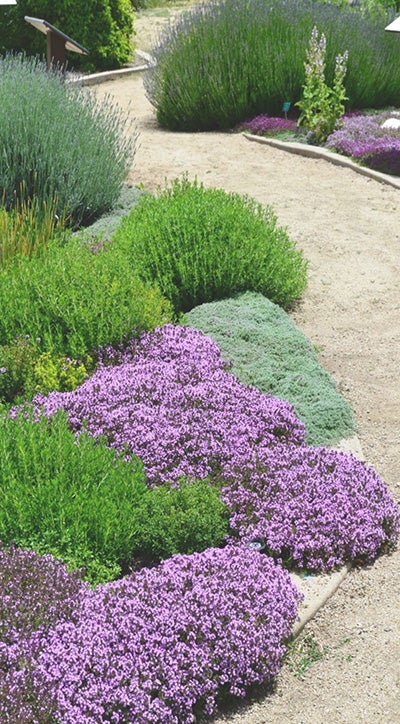Creating a beautiful, yet water-efficient landscape in the Rogue Valley is easier than you might think! Medford Water offers a variety of resources to help you save water outdoors while maintaining a lush landscape.
PLAN AHEAD TO BE WATER-WISE
Whether your style is formal or whimsical, you can add function and beauty to your landscape while reducing water needs. As you consider changes to your landscape, visit our Water-Wise Gardening site for hundreds of diverse photos providing a wide variety of attractive examples, highlighting water-wise gardening concepts tailored to the climate of the Rogue Valley.
You can search for different sizes and types of plants that can be grown locally, and in turn develop a list of favorites. Detailed Information on such aspects as whether plants prefer sun or shade, and their water needs is also provided. This can help you determine not only what plants you find attractive, but also which ones might be most appropriate and successful in specific locations.

Find a Landscaper
Need help creating an eye-catching, water-efficient landscape? The Landscape Contractors Board licenses landscape contracting businesses and professionals in Oregon. Use their business search to find a landscape contractor to install or maintain your landscape. Make sure you know what credentials to look for and services you should receive.
Consumers should use care and discretion when selecting a contractor. We encourage you to use these resources as well as the Oregon Landscape Contractors Association (OLCA) to research potential contractors, and the Occupational Safety and Health Administration to explore other resources for homeowners.
Soil Amendments
One factor that tends to receive too little attention when designing a landscape is the soil that serves as the base for the project. While it may be hard to get excited about dirt, it’s a good idea to consider amendments when not blessed with ideal loam. Most local soils are largely clay, which inhibits the penetration of water, and limits air spaces in the soil that plants need.
Since it’s easiest to improve soil before plants and irrigation systems are in place, it’s well worth giving attention to at the start. Most beneficial is the generous addition of organic material, tilling it well into existing soil. This will provide nutrients for plants while also helping soil absorb and retain water.
Irrigation
Try some of the following tips to avoid high summer-water use:
- Avoid watering every day, especially in the spring and early summer. You’ll encourage roots to grow down to seek water, and lessen the potential for plant diseases.
- Run sprinklers very early in the morning. Complete your watering before 6:00 a.m. to take advantage of calm air, the lowest temperatures of the day, and fewer competing water uses. There are even timers you can attach to your hose bib that can help you do this if you don’t have an automatic system.
- In our clay soils, water can’t soak in quickly. Instead of a single long watering cycle, run two or more shorter cycles with about an hour break between them. That way, water from each cycle can soak in before more is applied. Standard spray sprinklers can apply more water than clay soils can absorb in as little as five minutes, even less if your yard is sloped.
- Soil might look dry but still have plenty of moisture. If a 6-inch screwdriver goes easily into the soil, then wait to water.
- Run your sprinkler system manually about once a month to observe each zone operating. Are sprinklers working properly, pointing the right direction, and spray patterns not obstructed by vegetation?
- When you run your sprinklers, does the water come out in a fine mist, much of which just goes up into the air? This is a sign that the water pressure is too high for your sprinklers. Add a pressure regulator to your sprinkler system to eliminate this, and you could cut your sprinkler water use in half.
- Consider the long-term survivability of your current landscape and consider incorporating more climate-appropriate plants. Before selecting your plants study your environment; consider animals that exist in your landscape and your long-term needs, and make good ecological choices.
- Consider whether your yard has lawn areas that aren’t being used and could be replaced with something less demanding of water and maintenance – maybe ground covers and shrubs or a patio sitting area.
- Consider drip irrigation in shrub areas, and always irrigate grass separately from areas with shrubs and trees. If you’re installing an automatic irrigation system, make sure you install a good system from the start, as making changes later will be much more difficult. Also, make sure that you install proper backflow prevention devices. They are required for a good reason: to protect your household water supply.
- The goal of an irrigation system is to provide water as uniformly as possible. To help achieve this, make sure sprinkler spray patterns overlap, with all portions of your lawn receiving water from at least two sprinkler heads.
Watering Recommendations
Take the guesswork out of scheduling your sprinkler system, and follow our weekly watering recommendations! We use local weather data, combined with plant water needs, to develop a general weekly watering guide. Recommendations are updated weekly during the watering season.
See our current watering recommendations.